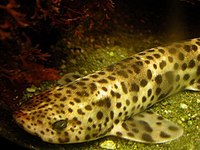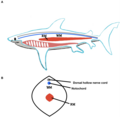Portal:Sharks
Welcome to the shark portal

Sharks are a group of elasmobranch fish characterized by a cartilaginous skeleton, five to seven gill slits on the sides of the head, and pectoral fins that are not fused to the head. Modern sharks are classified within the clade Selachimorpha (or Selachii) and are the sister group to the Batoidea (rays and kin). Some sources extend the term "shark" as an informal category including extinct members of Chondrichthyes (cartilaginous fish) with a shark-like morphology, such as hybodonts. Shark-like chondrichthyans such as Cladoselache and Doliodus first appeared in the Devonian Period (419–359 million years), though some fossilized chondrichthyan-like scales are as old as the Late Ordovician (458–444 million years ago). The oldest confirmed modern sharks (selachimorphs) are known from the Early Jurassic, about 200 million years ago, though records of true sharks may extend back as far as the Permian.
Sharks range in size from the small dwarf lanternshark (Etmopterus perryi), a deep sea species that is only 17 centimetres (6.7 in) in length, to the whale shark (Rhincodon typus), the largest fish in the world, which reaches approximately 12 metres (40 ft) in length. They are found in all seas and are common to depths up to 2,000 metres (6,600 ft). They generally do not live in freshwater, although there are a few known exceptions, such as the bull shark and the river shark, which can be found in both seawater and freshwater. Sharks have a covering of dermal denticles that protects their skin from damage and parasites in addition to improving their fluid dynamics. They have numerous sets of replaceable teeth.
Several species are apex predators, which are organisms that are at the top of their food chain. Select examples include the tiger shark, blue shark, great white shark, mako shark, thresher shark, and hammerhead shark. (Full article...)
Selected article -
Nursehounds have nocturnal habits and generally hide inside small holes during the day, often associating with other members of its species. A benthic predator, it feeds on a range of bony fishes, smaller sharks, crustaceans, and cephalopods. Like other catsharks, the nursehound is oviparous in reproduction. Females deposit large, thick-walled egg cases, two at a time, from March to October, securing them to bunches of seaweed. The eggs take 7–12 months to hatch. Nursehounds are marketed as food in several European countries under various names, including "flake", "catfish", "rock eel", and "rock salmon". It was once also valued for its rough skin (called "rubskin"), which was used as an abrasive. The conservation status of this species has not yet been evaluated by the International Union for Conservation of Nature (IUCN).
Did you know (auto-generated)

- ... that Hixxy and Sharkey created a schism in the UK rave music scene in 1995?
- ... that the ampullae of Lorenzini enable sharks to sense electric fields?
- ... that since 2018, IKEA's stuffed toy shark Blåhaj has become a popular Internet meme and an icon of the online transgender community?
- ... that "the Hurricane Shark is real"?
- ... that Alexis Sharkey's last Instagram post before her murder documented her travels to Tulum, Mexico?
- ... that Timo Meier became the first player in San Jose Sharks franchise history to score five goals in one game when he was 25?
Categories
Related portals
WikiProjects
Selected picture -

More Did you know? -
- ... that the spadenose shark exhibits the most advanced form of placental reproduction in fishes?
- ... that the dark, puffadder, brown, and Natal shysharks of South Africa are so named because they curl into a ring when threatened and "shyly" cover their eyes with their tails?
- ... that the daggernose shark can adjust the timing of events in its reproductive cycle by several months?
- ... that the lollipop catshark is shaped like a tadpole and has an almost gelatinous body?
- ... that the Australian swellshark can survive out of water for more than a day?
General images
Topics
For additional lists of marine life-related featured articles and good articles see:
Wikimedia
The following Wikimedia Foundation sister projects provide more on this subject:
-
Commons
Free media repository -
Wikibooks
Free textbooks and manuals -
Wikidata
Free knowledge base -
Wikinews
Free-content news -
Wikiquote
Collection of quotations -
Wikisource
Free-content library -
Wikispecies
Directory of species -
Wikiversity
Free learning tools -
Wiktionary
Dictionary and thesaurus















































